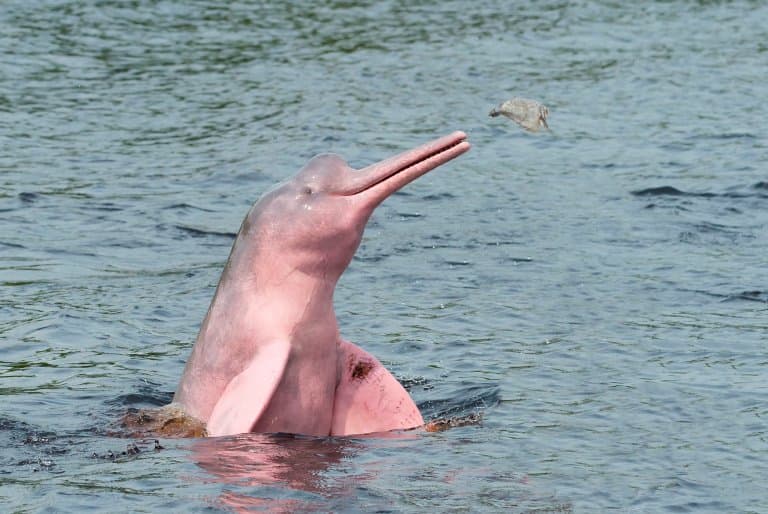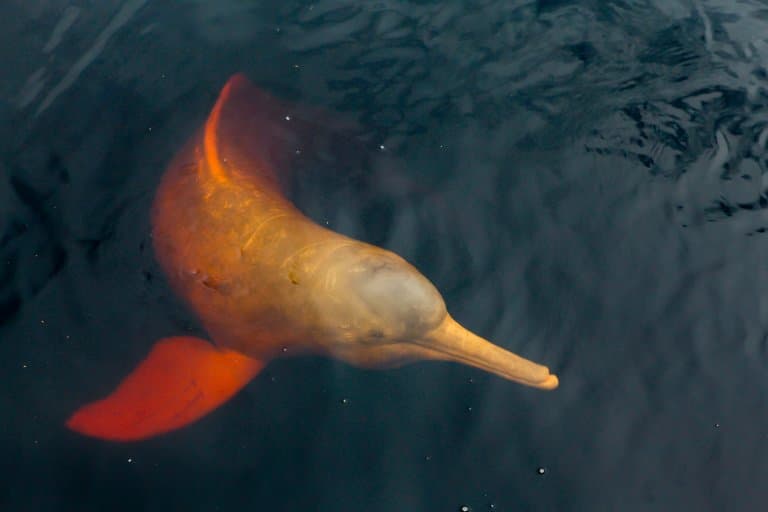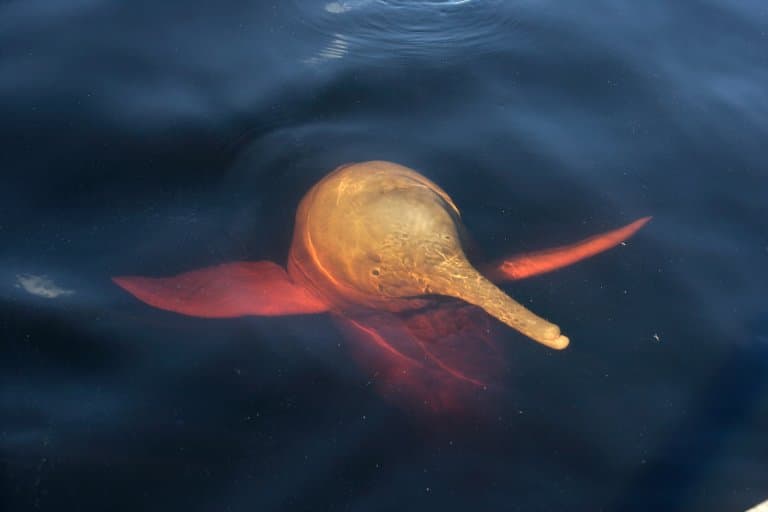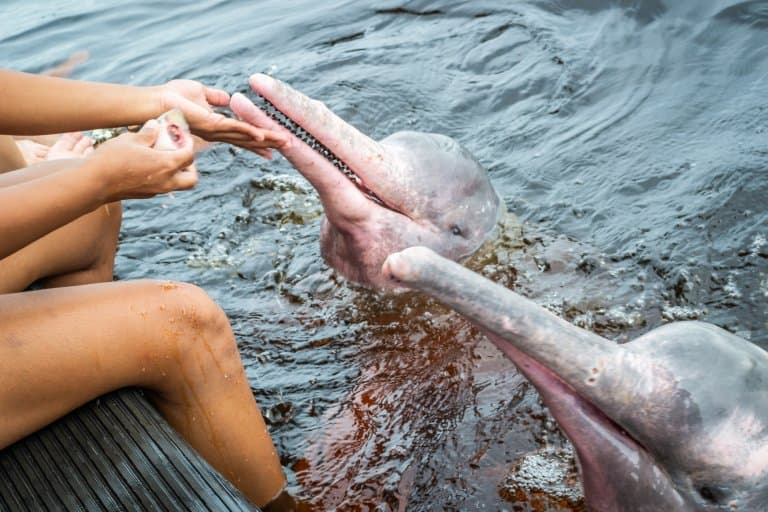Amazon River Dolphin Profile
If a guy in a hat tries to seduce you from the bank of the Amazon River, beware. He might be a shapeshifter! On the other hand, if you go swimming alone between dusk and dawn, you may also be carried off to their secret lair, which does sound cool.
This and many other legends surround the Amazon River dolphin, yet another freshwater cetacean that needs our help.
The Amazon river dolphin is a toothed whale, which are native to South America in the Amazon basin, Madeira river and Orinoco basin.

Amazon River Dolphin Facts Overview
| Habitat: | Wetlands |
| Location: | Amazon River, South America |
| Lifespan: | More than 46 years |
| Size: | Around 2.5m long (8.2ft) |
| Weight: | 185kg (408lb) |
| Colour: | Grey and pink |
| Diet: | Fish, turtles, crustaceans |
| Predators: | Humans |
| Top Speed: | 20 kph (12mph) |
| No. of Species: | 1 (3 subspecies, possibly 4) |
| Conservation Status: | Endangered (UUCN) |
There is a bit of confusion as to whether the river dolphins in the Amazon are all the same species or not, but regardless, the one known primarily as the Amazon river dolphin is the largest. Also called botos or bufeo, these are well known by locals for being not only pink, but also magic.
These strange-looking dolphins look very different from their oceanic relatives, and while they’re not quite as sexy, they are well adapted for life in the tangled, murky waters of flooded river basins.
Amazon river dolphins have a hightly varied diet and will eat over 50 different species of fish, as well as turtles, frogs and crabs.
Sadly, they’re threatened by human activity – as are all river dolphins – and are in decline.
Interesting Amazon River Dolphin Facts
1. They’re the largest river dolphin species in the world
Males are larger than female Amazon river dolphins and can grow up to 2.5m (8.2ft) in length and weigh as much as 185kg (408lb).
This is actually unique among river dolphin species, where females are generally larger than males.

2. They’re pink
This might be hardly surprising if you’re familiar with one of their most common names: pink river dolphins.
This colour isn’t pigmentation, instead, it comes from the dolphins rubbing themselves on rocks during playtime or fights. Males are generally pinker than females, but both are born grey and have to earn their scars over time.
There are several groups of river dolphins in South America and their taxonomy is a little controversial; some researchers suggest they’re all different subspecies, others think they’re distinct species.
The three recognized species are I. g. geoffrensis (Amazon river dolphin), I. g. boliviensis (Bolivian river dolphin) and the I. g. humboldtiana (Orinoco river dolphin). Then there’s the Araguaian river dolphin (I. araguaiaensis) and its position within the clade is unclear.
3. They’re revered by the region’s Indigenous communities
Among the local legends are stories of river dolphins transforming themselves into men to seduce women.
Tales warn young women of mysterious fishermen who come only at night and tell the story of one particular case where a woman was impregnated by this shapeshifter, only to die giving birth to a river dolphin.
These dolphins in human form wear a hat to disguise their blowhole and are accused of fathering illegitimate children.
Children without a father are sometimes called “children of boto” as a reference to the local name for this dolphin. 1 2

4. They’re not elegant
While marine dolphins are streamlined, have good eyesight and are clearly built for chasing prey at speed, their riverine descendants are not nearly as tidy.
Some have bulbous heads with elongated noses, and are seemingly disproportionate. But this isn’t a handicap; on the contrary, these dolphins are specialised for hunting in the tangled roots of flooded tropical forest areas.
They also have unfused necks, further contributing to their agility, and a smaller size really helps out in this environment. Their extra-long nose helps them dig out small fish and crustaceans in the mud, and due to their murky water habitat, they’ve lost most of their eyesight too.
Instead, they manipulate their bulbous head, or melon, to direct biosonar and see in the dark!
5. They can click 30-80 times a second
The Amazon river is incredibly murky and these dolphins have tiny eyes, so they rely more on their echolocation abilities, rather than sight for navigation and hunting prey.
While hunting in murky water, they make a sequence of clicking noises at 30 to 80 times per second, which they utilise to hear the bouncing sonar off their prey to identify their location.
As well as clicks, these dolphins will also vocalize to each other using whistles. Researchers believe they will whistle to each other when hunting for food.
6. Males present turtles to impress females
During courtship displays, male pink river dolphins have been seen catching turtles and raising them out of the water to show off.
Mating occurs from when the female is around 5 years old, and birth comes up to fifteen months later. The calf hangs around with the mother for a year or more, which makes reproduction relatively slow, and thus this is a species vulnerable to outside threats.
Sadly, while these are apex predators and sacred to the local human population, the wider communities do not hold the same respect for the animals and they are in serious trouble. 3
7. They’re full of mercury
Mercury pollution is a huge problem and stems from gold mining in the Amazon.
Mercury enters the food web at the lower trophic levels and is sequestered in the top predators like the dolphins as they eat catfish contaminated with it.
Mercury levels found in river dolphins are alarmingly high and can affect brain function and reproductive fitness.

8. They are thought to compete with humans for food
They’re also killed deliberately by humans who believe the dolphins are stealing their catches.
Otherwise, they can be killed for bait to catch other catfish, and this contributes to a significant percentage of the dolphins caught in nets on the Amazon River.
It’s thought that up to or exceeding 4,000 river dolphins are caught each year. 4
9. And are often poisoned or blown up
It’s also noted that fishermen throw in poisoned fish to reduce the river dolphin populations thought to compete for their food sources.
Other impacts of fishing include the inevitable bycatch and the destructive nature of dynamite fishing.
This sort of treatment for an apex predator isn’t just a tragedy, but also spells disaster for the local ecosystems, but conservation in many of their habitats isn’t as easy as it might seem.
10. Their conservation can be dangerous
Many conservationists in developed countries take for granted the struggles faced by their counterparts in less stable regions of the world.
In many countries in South and Central America, environmentalists and conservationists are killed as pests by the corporate agents involved in the damage that the activists are trying to address.
In trying to draw attention to the plight of the river dolphin and the polluting activities that threaten them, people have received death threats and even been rounded up and executed.
One researcher in particular, Fernando Trujillo has received death threats for warning of mercury levels in catfish in the process of supporting pink river dolphin communities. He now wears a bulletproof vest and travels with a bodyguard. 5

Amazon River Dolphin Fact-File Summary
Scientific Classification
| Kingdom: | Animalia |
| Phylum: | Chordata |
| Class: | Mammalia |
| Order: | Cetacea |
| Family: | Iniidae |
| Genus: | Inia |
| Species: | Inia Geoffrensis |
Fact Sources & References
- “Boto Encantado”, Mermaid Wiki.
- “The Legend Of The Pink River Dolphin”, Rainforest Cruises.
- “Amazon River Dolphin”, National Geographic.
- V. Trujillo (2018), “Amazon River Dolphin”, IUCN Red List.
- “The pink river dolphins of the Amazon have a warning for humans”, The Washington Post.
